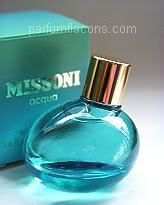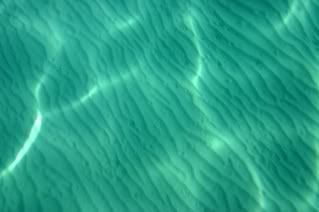 In the 3rd century, it was believed to protect against falling off a horse, to attract poisons, heal the eyes and aid against bites from snakes and scorpions. Changes in its shade indicated the infidelity of a wife. Arabian writings claimed "The turquoise shines when the air is pure and becomes pale when it is dim." (12th century AD) A gemstone truly immersed in legend!
In the 3rd century, it was believed to protect against falling off a horse, to attract poisons, heal the eyes and aid against bites from snakes and scorpions. Changes in its shade indicated the infidelity of a wife. Arabian writings claimed "The turquoise shines when the air is pure and becomes pale when it is dim." (12th century AD) A gemstone truly immersed in legend!Olivier Durbano, architect and jewellery designer, has created the line Parfums de Pierres Poèmes, liquid poems that interpret the magic of gemstones into fizzying emitions on the skin. After Tourmaline Noire, Amethyste, Cristal Rock, Jade, which took olfactory life thanks to tea, incense, jasmine and amber, now Turquoise joins the small and elegant line with a fragrance in the corresponding pastel greenish-blue hue of the semi-precious gemstone.
Turquoise, a hydrous phosphate of copper and aluminium, has been prized for its beautiful intensity of shade and rich, opaque feel since antiquity. It has adorned rulers of Ancient Egypt, the Aztecs, Persian and Mesopotamian priests and kings, and to some extent it has been also used in ancient China since at least the Shang Dynasty. In Egypt the first proof of use dates to the First Dynasty (3100-2890 BC), culminating into the iconic Tutankhamun's burial mask, but allegedly even prior to that turquoise was prized by the Egyptians and therefore mined in the Sinai Peninsula, called "Country of Turquoise" by the native Monitu. Etymologically the word derives from the 16th century French, either denoting Turkish origin (turquois) or evoking dark-blue stone (pierre turquin). However the best and highest-grade turquoise (a uniform robin egg's blue) always came from Persia/Iran, brought to Europe via the Silk Route and the writings of Marco Polo. But the beauty of the stone, heavily traded in Turkish bazaars and lovingly capturing the wonderful colour of the Mediterranean Sea of the Turkish coasts ~which inspired the Seljuks to adorn their abodes and homes with decorative tiles in these sunny shades~ might have accounted for the misattribution. In the words of Gubelin: " "This misnomer is readily explained by the fact that the first stones did not reach Europe directly from Persia [i.e., Iran], but rather through the intercession of seafaring Venetians who purchased them at Turkish bazaars." [1]
The deposits of California and New Mexico were mined by pre-Columbian Native Americans using stone tools and the stone is ingrained into their cultural and philosophical beliefs resulting in ceremonial jewellery and masks of astonishing ~and sometimes disturbing~ designs. The Apache Indians believed turquoise to combine the spirits of both sea and the sky, while the Navajo attributed to it qualities of an ex caelis fallen stone (a gem fallen from heavens). The Zunis of North America thought the blue of the sky represents light from their "spirit bird" reflected from the top of a mountain of turquoise. However, in an opposite sense other Native Americans of the southwestern United States region are said to have thought turquoise so-to-speak stole its color from the sky.
 All these thoughts come to me as I contemplate how Olivier Durbano will interpret turquoise into what seems like a woody-ozonic fragrance with accents of incense like the rest of his line. The "mineral" quality of fragrances usually relies on synthesized materials, such as quinolines, aldehydes, and certain synthetic musks. [2] But in Olivier Durbano's Turquoise, the notes indicate a fragrance which evokes the milieu in which turquoise shines best, the cool azure of the sea and the warm tint of a clear summery sky. So the experiment is exciting to anticipate.
All these thoughts come to me as I contemplate how Olivier Durbano will interpret turquoise into what seems like a woody-ozonic fragrance with accents of incense like the rest of his line. The "mineral" quality of fragrances usually relies on synthesized materials, such as quinolines, aldehydes, and certain synthetic musks. [2] But in Olivier Durbano's Turquoise, the notes indicate a fragrance which evokes the milieu in which turquoise shines best, the cool azure of the sea and the warm tint of a clear summery sky. So the experiment is exciting to anticipate.Gemstones and jewels have been nothing new to perfumery as a baptism concept, from the groundbreaking Emeraude by Coty and little-known vintage Blue Sapphire by Lynette New York, through the Elizabth Taylor commemorative collection and Paco Rabanne's aptly named Liquid Crystal, right up to Gem and Birmane (evoking rubies)by Van Cleef & Arpels (jewellers themselves). Lately many fragrances re-immersed themselves into the luxurious aspect that gems give: The Durbano line of course, some from Avon, Lalique Amethyst, Jette Joop Dark Sapphire, the Bulgari Omnia line (Améthyste, Green Jade, Crystalline), Versace Bright Crystal, the Sage Machado line, the Armani Privé line (with Pierre de Lune, Cuir Améthyste, Eau de Jade), Patricia de Nicolai Eau Turquoise, all the way to Lauder's Emerald Dream and the completely unknown (and dubious?) to me Aqua Sapphire by Guerlain.
No one can resist a little glimpse of bling-bling it seems!
Turquoise by Olivier Durbano features the following notes:
Head notes: Maritime pine resin, roseberry, elemi, Somalian incense, coriander, juniper
Heart notes: Alga fucus (seaweed), lily, fragrant reed, lotus blossom
Base notes: Everlasting Flower/Immortelle/Helycrisum, honey, myrrh wood, ambergris
[1]Link
[2]Jean Claude Ellena classification
.jpg)




.jpg)


